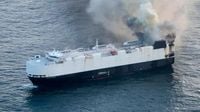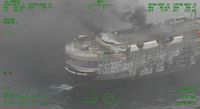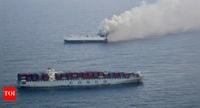The cargo ship Morning Midas sank in the North Pacific Ocean on June 23, 2025, weeks after a devastating fire forced its crew to abandon the vessel. This 600-foot ship, registered under the Liberian flag and managed by London-based Zodiac Maritime, was transporting over 3,000 new vehicles from Yantai, China, to a major Pacific port in Mexico when the incident unfolded.
The fire aboard the Morning Midas broke out on June 3, approximately 300 miles southwest of Adak Island, Alaska, in international waters. According to the U.S. Coast Guard, the blaze originated near the ship’s stern, the section where about 70 fully electric vehicles and nearly 680 hybrid cars were stored. A significant plume of smoke was observed rising from this area, raising concerns about the role of lithium-ion batteries, which are known to pose fire risks if damaged or improperly handled.
Despite extensive efforts to contain the fire, the Morning Midas sustained severe damage. The situation worsened as adverse weather conditions and water seepage compromised the vessel’s integrity. As a result, the ship ultimately sank in waters approximately 16,400 feet deep and about 415 miles from land, roughly 450 miles southwest of Adak Island. The sinking was confirmed by the U.S. Coast Guard late on June 23, 2025.
All 22 crew members aboard the Morning Midas evacuated safely using lifeboats on June 5, two days after the fire started. They were rescued by the nearby container ship COSCO Hellas, with no injuries reported. Zodiac Maritime emphasized that the evacuation was carried out in accordance with established emergency procedures, ensuring the crew’s safety throughout the ordeal.
The ship was carrying a total of 3,048 vehicles, including approximately 70 fully electric and 681 hybrid models. While it remains unclear if any vehicles were salvaged before the sinking, Zodiac Maritime has not provided detailed information about the cargo’s fate. Some reports suggest the cargo included vehicles from prominent Chinese automakers such as SAIC Motor, Chery Automobile, and Great Wall Motor.
At the time of the incident, the Morning Midas was also carrying significant fuel quantities: about 350 metric tons of marine gas oil and 1,530 metric tons of very low sulfur fuel oil. This raised environmental concerns, prompting a swift response from the U.S. Coast Guard and Zodiac Maritime. Two salvage tugs equipped with pollution control gear, named Garth Foss and Salvage Worker, were dispatched to the scene shortly after the fire disabled the vessel. These tugs remain stationed at the site to monitor for any signs of oil spills, floating debris, or other pollution risks.
In addition to the salvage tugs, Zodiac Maritime is sending a specialized pollution response ship, the Endeavour, from Dutch Harbor. Expected to arrive by June 27, 2025, the Endeavour is outfitted with advanced oil spill containment and recovery equipment, underscoring the commitment to preventing environmental damage. Capt. Christopher Culpepper, commander of Coast Guard Sector Western Alaska and U.S. Arctic, stated, "The safety of the responders remains our top priority. We're working closely with Zodiac Maritime in an advisory capacity to ensure a swift and effective response to any potential signs of pollution." Petty Officer Cameron Snell, a Coast Guard spokesperson based in Alaska, added, "There is no visible pollution. Right now we also have vessels on scene to respond to any pollution."
The sinking of the Morning Midas has reignited global concerns about fire safety on ships transporting electric vehicles. Lithium-ion batteries, while revolutionary for the automotive industry, have been linked to several maritime fire incidents due to their volatile nature when damaged. This is not an isolated case; in 2023, a similar fire broke out on a freighter carrying around 3,000 vehicles, including nearly 500 electric cars, en route from Germany to Singapore. That fire lasted for a week, tragically resulting in one fatality and multiple injuries before the ship was towed to a port in the Netherlands for salvage.
Following that 2023 incident, the Dutch Safety Board issued a report calling for improved emergency preparedness and response measures on maritime shipping routes, especially those involving cargoes with electric vehicles. The board emphasized the need for better coordination, enhanced firefighting capabilities, and stricter safety protocols to prevent such disasters in the future.
The Morning Midas tragedy highlights the ongoing challenges faced by the maritime industry as it adapts to the increasing transportation of electric vehicles. As automakers worldwide accelerate the production of EVs and hybrids, shipping companies must grapple with the associated risks, particularly the fire hazards posed by lithium-ion batteries. Experts suggest that more rigorous safety standards, improved fire detection and suppression systems, and specialized crew training are critical steps toward mitigating these dangers.
Built in 2006, the Morning Midas had been in service for nearly two decades before its final voyage. Departing from Yantai, China, on May 26, 2025, the ship was destined for Lázaro Cárdenas, one of Mexico’s major Pacific ports. The loss of the vessel and its cargo represents a significant blow to the automotive supply chain, illustrating the vulnerabilities of global trade networks reliant on maritime transport.
Environmental officials continue to monitor the site closely, but so far, no visible pollution has been detected. The coordinated response between the U.S. Coast Guard and Zodiac Maritime aims to prevent any potential ecological damage from fuel leaks or debris. Meanwhile, the maritime community and regulatory bodies are likely to revisit safety regulations governing the shipment of electric vehicles, seeking to prevent future catastrophes.
As the industry reflects on the lessons from the Morning Midas and previous incidents, the question remains: how will shipping companies balance the growing demand for electric vehicle transport with the imperative of safety and environmental protection? For now, the crew’s safe evacuation stands as a testament to effective emergency protocols, even as the broader challenges posed by lithium-ion battery fires at sea continue to loom large.



